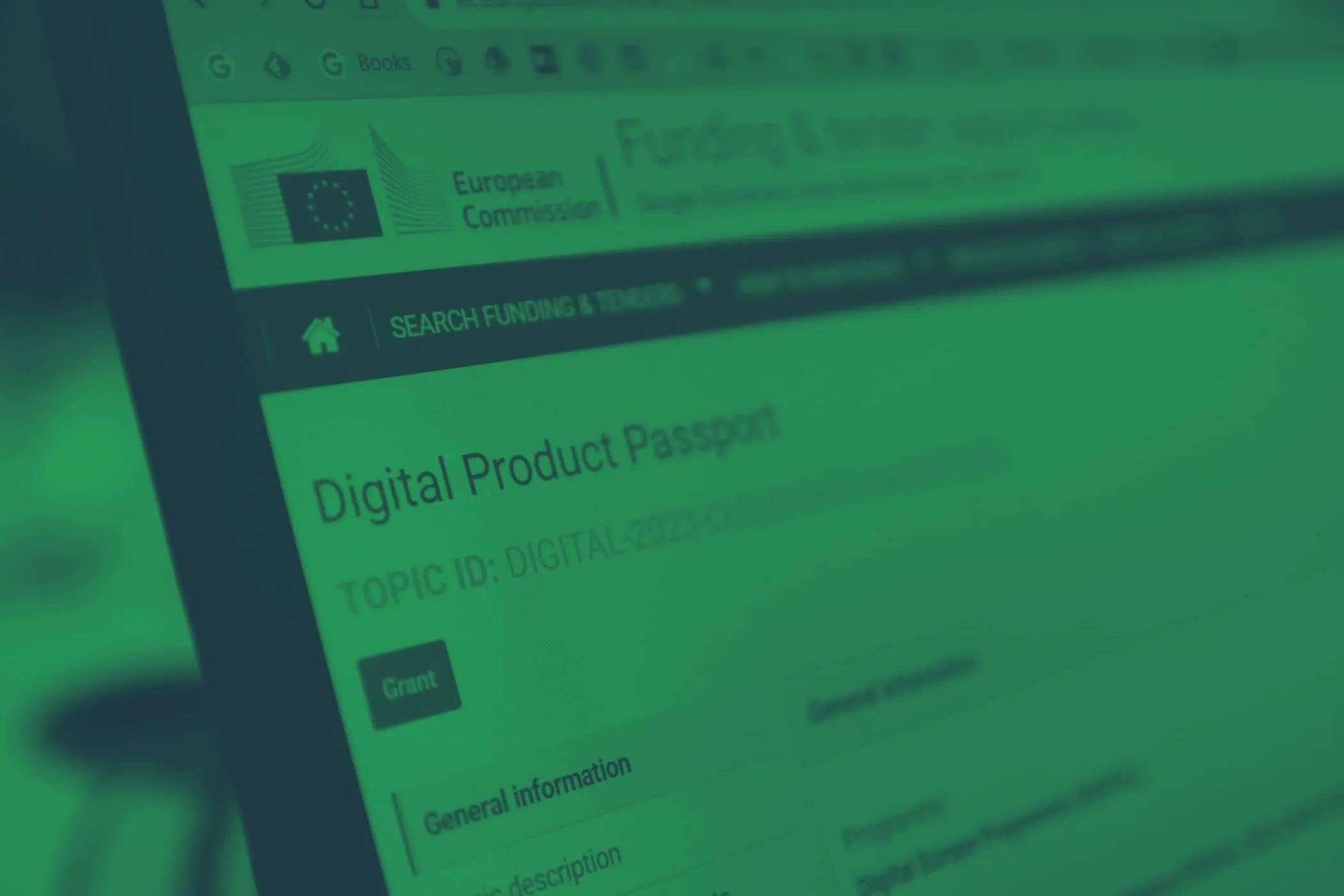EU’s idea of a “Digital Product Passport” (DPP), intended to make product sustainability visible, is gradually maturing through both calls for proposals and academic literature. As a PIM system owner, you are well positioned to meet the upcoming requirements.
EU is currently working on a so-called “Digital Product Passport” (DPP). The passport is a digital tool designed to contain data about every product’s environmental impact on parameters such as sustainability and recyclability.
With the Digital Product Passport, EU hopes to accelerate investments in the green transition and to eliminate the trade of goods that do not have a sufficiently sustainable profile.
If the DPP becomes a reality, many companies will face a major documentation challenge – in some cases needing to support hundreds of new data points per product. As a PIM owner, you naturally have a strong tool at your disposal when the new requirements take effect.
And many companies face a huge challenge. Some more than others. Those who already have a PIM system are further ahead than those who don’t. Because PIM is the perfect place to store the data that must be included in a Digital Product Passport.
In this post, we explore how far the development has come, the consequences the rollout of the Digital Product Passport will have, and how a PIM system can support compliance with future sustainability documentation requirements.

Ready to talk data?
We’d be happy to share our perspective on how data can support your business in executing, growing, and scaling – feel free to reach out for a no-obligation conversation.
What is a “Digital Product Passport” (DPP)?
Just like the passport we know, the digital product passport is a document that must accompany the product on its journey – from production to phase-out. The passport’s function is to serve as the primary source of information about the product’s sustainability profile, including possibilities for recycling.
The digital product passport is born in and by EU, and is currently still a theoretical construct that needs to mature, among other things through a series of “Call for proposals,” where aspects related to format and scope must be clarified.
In 2022, an EU committee published the document ”On making sustainable products the norm”, in which the digital product passport is described:
“Digital product passports will be the norm for all products regulated under the ESPR, enabling products to be tagged, identified and linked to data relevant to their circularity and sustainability […] Depending on the product concerned, this can include information on energy use, recycled content, presence of substances of concern, durability, reparability, including a reparability score, spare part availability and recyclability.”
(Source; Europa.eu)
Documentation requirements for the entire product lifecycle
Everything from material procurement to how the product should/can be reused is planned to be documented in the digital product passport. Initially, the passport can only be accessed digitally in the form of either a QR code, an NFC chip, or an RFID tag.
Data collection starts in the product’s early design phase, where it is documented;
- which materials the product consists of
- where the materials come from
- and where the product is manufactured
The digital passport is therefore planned to be updated from the product’s inception. The passport must then be continuously updated to show exactly where and when the product is sold, where it is/has been shipped, repaired, or if the product has been subject to repair.
In other words, this is a very ambitious concept whose success depends on establishing and updating thousands of different data touch points in connection with production, logistics, service, and disposal of both the whole product and parts of it.

How is a Digital Product Passport used?
With the DPP project, EU hopes to solve many of the challenges associated with establishing a circular economy. An underlying assumption in EU’s statements about the DPP is that increased transparency regarding sustainable production will increase consumers’ incentives to make climate-conscious choices.
Today, there are no products that fully document which resources are involved in the product’s journey from cradle to grave.
Nor are there many that document how their products can be reused, and how different components in the product can be recycled. Naturally, this is because there is a huge amount of work involved in producing, exchanging, and maintaining this information.
The DPP introduces requirements for documentation, although it has not yet been decided how the responsibility for ensuring accurate documentation will be distributed, or how these requirements will be controlled.
At present, the only thing we know is that EU envisions the following scenario: Throughout the product’s entire lifecycle, any actor interacting with the product (manufacturers, wholesalers, shippers, customers, repairers, etc.) will be able to scan the product’s digital product passport and immediately see all information about the product’s environmental impact.
In other words, the introduction of the DPP will put pressure on the companies that produce and distribute the products, which we will discuss later in the article.

How the DPP benefits the end user
The Digital Product Passport is also intended as a way to give customers better insight into the product’s overall environmental impact throughout its entire lifetime. When every step in the product’s supply chain is documented, this helps put pressure on companies, which will need to adapt their business to a greener agenda.
The underlying argument from EU is that the environmentally conscious consumer will increasingly gravitate toward sustainable consumption as it becomes possible to understand the total environmental footprint of products:
“Combining this with the right consumer information and ensuring protection against green-washing, EU would meaningfully empower its consumers for the green transition and make sustainable products the norm, inspiring the rest of the world to follow.”
(Source: Europa.eu)
With the DPP, EU also aims to create a solid decision-making foundation for the consumer, who is assumed to be driven by sustainability.
One unresolved question, however, is whether the extra cost associated with maintaining the required level of documentation will be passed on to consumers in the form of higher prices, which risks making cheaper, non-sustainable products more attractive.
What data requirements does the DPP impose?
As mentioned, EU is still in the process of defining the data requirements that must be included in the DPP. This includes standardizing definitions and the process for data collection, which remain unresolved.
At present, we interpret that the DPP should include these types of data:
- Basic product data: Product name, brand, model, batch number, production date, and warranty data
- Material data: Origin of raw materials and components as well as the suppliers involved in sourcing materials and components.
- Ownership data: Details about current and previous owners (especially for products with a long lifespan, which are often resold)
- Repair data: How the product can be repaired, any special services, and reasons for repairs
- Sustainability data: CO2 footprint related to production and logistics processes involved in manufacturing the product.
In some circles, there is optimism (or pessimism – depending on the perspective), highlighting that the DPP will mean hundreds or thousands of new fields per product. Others are more conservative and expect the DPP to become more fragmented and industry- or category-specific, resulting in fewer data requirements per product.
We take a neutral stance and currently maintain some distance from the DPP concept until the first Calls for proposals and conclusions are made available to the general public.

Who is affected by the introduction of the DPP?
If the DPP is implemented in its current form, there can be little doubt that it will have a significant impact on a wide range of manufacturers. Complex products have complex supply chains, and for years the connections between actors in these chains have often been unclear.
The DPP will very likely mark the beginning of the end of an era where the responsibility for enriching product data is fragmented and incomplete. In other words, companies will no longer be able to operate without a deep understanding of the design, production, usage, and recycling phases of their products.
At the same time, this means that many companies will need to rethink their business models, particularly their handling of contracts with partners, as responsibility for data enrichment must be distributed.
According to EU, companies that succeed in formulating and implementing new business and cooperation models that meet the requirements of the DPP will be able to strengthen their brand with a sharper green profile.

Is the Digital Product Passport only relevant for companies and consumers in EU?
Although the digital product passport is an EU regulation, the initiative will likely affect actors across the entire value chain worldwide. In the current interpretation of the DPP concept, it is easy to imagine that a global electronics manufacturer headquartered in North America, producing laptops in Asia and selling them in Europe, will have to comply with the requirements set out in the DPP regulation in order to sell their goods in EU.
Regardless of where the product is manufactured or where the producer is located, the digital product passport will thus influence global trade – and not just key players in Europe.
A study from the US shows that American consumers are the most willing to pay more for environmentally friendly/sustainable products and services (Source: Kezzler.com).
Therefore, American companies may also see a new regulation as an opportunity to strengthen their brand in North American markets, and not just as (yet) a compliance requirement that is costly but does not create value for their core business.
When will the Digital Product Passport become a reality?
The DPP regulation will eventually affect a wide range of industries/product categories. The DPP is expected to be rolled out gradually from sector to sector, allowing continuous learning and knowledge gathering on how the regulation is best managed and enforced.
Batteries – specifically industrial and electric vehicle batteries – are planned to be the first area where the DPP regulation takes effect. Although the DPP will not impact these product categories until 2026, industry associations are already taking the necessary steps to ensure compliance, and the first proof of concept was unveiled at this year’s Economic Forum in Davos (Source: Umicore.com).
Shortly thereafter, the electronics and textile sectors are expected to follow suit. Here is an overview of the most notable deadlines announced so far:
| Category | Expected Deadline | Expected Regulation |
|---|---|---|
|
Batteries |
2026 |
EU’s new battery regulation: https://ec.europa.eu/commission/presscorner/detail/en/ip_22_7588 |
|
Textiles |
2027–2028 |
EU’s strategy for sustainable and circular textiles: https://www.interregeurope.eu/news-and-events/news/new-eu-strategy-for-sustainable-and-circular-textiles |
|
Electronics |
2027–2028 |
EU’s Ecodesign for Sustainable Products Regulation: https://environment.ec.europa.eu/publications/proposal-ecodesign-sustainable-products-regulation_en |
|
Construction materials |
Unknown |
EU’s regulation for construction products: https://ec.europa.eu/commission/presscorner/detail/es/qanda_22_2121 |

How to leverage PIM when data volume and quality requirements increase
Although the deadlines are not yet fully defined, it appears that the DPP initiative will become a reality within a foreseeable timeframe.
In the meantime, many companies should evaluate whether their products and product data will be covered by the upcoming regulations, and how they will ensure compliance if so.
This work could, for example, include defining necessary processes for data collection and storage, developing new/updated information flows to/from suppliers concerning new transparency requirements, and identifying gaps in the company’s knowledge that may hinder compliance.
Where does the PIM system come into play?
The digital product passport stands out as yet another sign that sustainable business practices are here to stay. With the DPP initiative, the value of the PIM system to the business also becomes evident.
Increasing requirements for data (both in volume and quality) will raise the need for sound processes and solid technological support. With a PIM system, managing large amounts of product data becomes feasible. At the same time, most PIM systems (e.g., Perfion and inriver) offer features that directly support the work involved in acquiring, enriching, and publishing data in line with the activities required by the DPP.
As PIM specialists, we’re keeping our eyes and ears open for all DPP-related news, as large parts of our customer base will undoubtedly need to meet growing product data requirements in the years to come.


